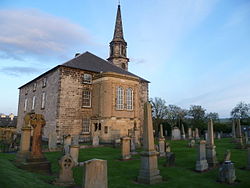Inveresk
| Inveresk Gaelic: Inbhir Easg | |
| Midlothian | |
|---|---|
 Inveresk Parish Kirk | |
| Location | |
| Grid reference: | NT346719 |
| Location: | 55°56’13"N, 3°2’49"W |
| Data | |
| Post town: | Musselburgh |
| Postcode: | EH21 |
| Dialling code: | 0131 |
| Local Government | |
| Parliamentary constituency: |
East Lothian |
Inveresk is a village and parish in Midlothian situated immediately to the south of Musselburgh. It forms one of the finest conservation areas in Scotland having been designated a conservation area since 1969. It is situated on slightly elevated ground on the north bank of a loop of the River Esk. This ridge of ground, 60 to 80 feet above sea level, was used by the Romans as the location for a fort in the 2nd century AD.[1]
The element "Inver", from the Gaelic inbhir, refers to the confluence of the river Esk with the Firth of Forth.[2]
Inveresk is notable for its fine street of 17th- and 18th-century houses. Inveresk Lodge is now privately leased, but the adjacent Inveresk Lodge Garden belongs to the National Trust for Scotland, and its west facing gardens overlooking the river Esk are open to the public. This was formerly the mansion of James Wedderburn who had made his fortune as a slave-owning sugar plantation owner in Jamaica. When his son by one of his slaves, Robert Wedderburn, travelled to Inveresk to claim his kinship he was insultingly rejected by his father who gave him some small beer and a broken or bent sixpence. This experience turned Robert Wedderburn to radicalism.
Contents
St Michael's Church
The village is dominated by the disproportionately large St Michaels standing at its west end on the apex of the local hill, viewing down over Musselburgh. It has a truly huge and even more disproportionate graveyard/cemetery stretching westwards for almost 300 yards split into separate walled sections (marking its various stages of extension) which can be broadly bracketed as original (mainly 18th century), a late Victorian extension, an Edwardian/ early 20th century extension to the north, and a modern section to the far west.
The current church is by Robert Nisbet and dates to 1805 and has a remarkably fine stone spire of Wren-influence but is believed to date to the 6th century.[3]
Noteworthy Graves
Not unsurprisingly, this huge graveyard has a number of interesting graves:-
- A remarkable white-painted, cast-iron sculpture of a coffin draped in military regalia, atop a full-sized cannon and cannonballs, just south of the church marking the grave of Major William Norman Ramsay of Waterloo fame
- A monument to seven fishermen from Fisherrow of the fishing-boat "Alice of Boddam", lost in the storm of 14 October 1881 (generally referred to as the Eyemouth Disaster).
- Curious cubic gravestones to Admiral Archibald Cochran (d.1843) and his son Admiral Thomas Cochran (d.1888)
- Rev William Lindsay Alexander (1808–1884)
- John Cran, shipbuilder (1849–1940)
- The Buller-Elphinstone tomb: William Elphinstone, 15th Lord Elphinstone, Sidney Elphinstone, 16th Lord Elphinstone (a sarcophagus-style monument at the east end of the Victorian section)
- James Greenlees (1870–1951) rugby player and scholar, headmaster of Loretto College 1926-41 (a atone on the west wall of the Victorian section)
- A large monument to several of Hope Baronets of Craighall (against the far east wall)
- Major General Sir Patrick Lindesay (1778–1839), military hero, Acting Governor of New South Wales in 1831 (stone fully obscured by yew trees)
- John Grieve: John Grieve was awarded the Victoria Cross for his bravery at the Battle of Balaklava in the Crimean War.
- Admiral Sir David Milne 1763-1845, his son Admiral Sir Alexander Milne 1806-1896 and his geologist son David Milne-Home 1805-1890
- David Rae, Lord Eskgrove (1724–1804) (on the outer south-west corner of the church)
- Sir William Rae, 3rd Baronet (1769–1842) son of the above, buried with his father
- Alexander Handyside Ritchie sculptor (1804–1870)
- The Wedderbrn tomb: Sir David Wedderburn, 1st Baronet (1775–1858), Sir John Wedderburn, 2nd Baronet, Sir David Wedderburn, 3rd Baronet (1835–1882)
Other Notable Persons linked to Inveresk
- Angus Fulton (engineer) 1900-1983, died here
- James Murray, 2nd Duke of Atholl, buried here.
- Robert Mylne, architect/master mason, 1633–1710, lived and died here
- Clarissa Dickson Wright the chef and broadcaster lived here until her death in March 2014.[4]
- Henry Yule (1820–1899), Scottish Orientalist, born here
References
- ↑ Burnet, JEM (1999) A reason for Inveresk. Courtyard Press, Inveresk. ISBN 0-9537450-0-7
- ↑ Dixon, Norman. "The Placenames of Midlothian" (PDF). http://www.spns.org.uk/PNsMIDLOTHIANv3.pdf. Retrieved 2012-07-04. "'The mouth of the R. Esk' v. G. inbhir, inbhear: 'the confluence of a stream with the sea.'"
- ↑ Buildings of Scotland: Lothian, by Colin McWilliam
- ↑ Dickson Wright, Clarissa (2012). Clarissa's England: A gamely gallop through the English counties. Hodder & Stoughton. ISBN 9781444729139.
Outside links
| ("Wikimedia Commons" has material about Inveresk) |




